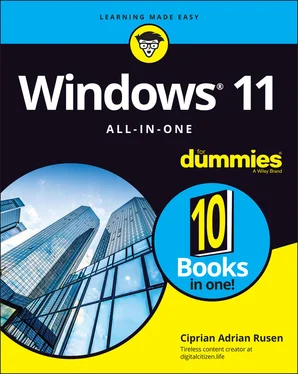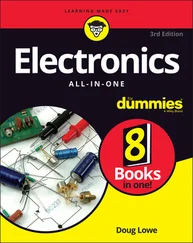Windows includes many drivers, some created by Microsoft and others created by third parties. The hardware manufacturer is responsible for making its hardware work with your Windows PC, and that includes building and fixing the drivers. However, if Microsoft makes your computer, Microsoft is responsible for the drivers, too. Sometimes you can get a driver from the manufacturer that works better than the one that ships with Windows.
When you stick an app or a program on your computer — and set it up so that you can use it — you install the app or program (or driver).
When you crank up a program — that is, get it going on your computer — you can say you started it, launched it, ran it, or executed it. They all mean the same thing.
If the program quits the way it’s supposed to, you can say it stopped, finished, ended, exited, or terminated. Again, all these terms mean the same thing. If the app stops with some weird error message, you can say it crashed, died, cratered, croaked, went belly up, jumped in the bit bucket, or GPFed (techspeak for “generated a General Protection Fault” — don’t ask), or employ any of a dozen colorful but unprintable epithets. If the program just sits there and you can’t get it to do anything, no matter how you click your mouse or poke the screen, you can say that it froze, hung, stopped responding, or went into a loop.
A bug is something that doesn’t work right. (A bug is not a virus! Viruses work as intended far too often.) US Navy Rear Admiral Grace Hopper — the intellectual guiding force behind the COBOL programming language and one of the pioneers in the history of computing — often repeated the story of a moth being found in a relay of an ancient Mark II computer. The moth was taped into the technician’s logbook on September 9, 1947. (See Figure 1-4.)

Source: US Navy
FIGURE 1-4:Admiral Grace Hopper’s log of the first actual case of a bug being found.
The people who invented all this terminology think of the internet as being some great blob in the sky — it’s up, as in “up in the sky.” So, if you send something from your computer to the internet, you’re uploading. If you take something off the internet and put it on your computer, you’re downloading.
The cloud is just a marketing term for the internet. Saying that you put your data “in the cloud” sounds so much cooler than saying you copied it to storage on the internet. Programs can run in the cloud — which is to say that they run on the internet. Just about everything that has anything to do with computers can be done in the cloud. Just watch your pocketbook.
 If you use cloud storage , you’re just sticking your data on some company’s computers. Put a file in Microsoft OneDrive, and it goes onto one of Microsoft’s computers. Put it in Google Drive, and it goes to Google’s storage in the sky. Move it to Dropbox, and it’s sitting on a Dropbox server.
If you use cloud storage , you’re just sticking your data on some company’s computers. Put a file in Microsoft OneDrive, and it goes onto one of Microsoft’s computers. Put it in Google Drive, and it goes to Google’s storage in the sky. Move it to Dropbox, and it’s sitting on a Dropbox server.
When you connect computers and devices to each other, you network them. The network can be wired, using cables; wireless, often called Wi-Fi , the name for the main body of wireless networking standards; or a combination of wired and wireless. At the heart of a network sits a box, called a router or an access point, that computers connect to via cables or Wi-Fi. If the router has “rabbit ears” on top, for wireless connections, it’s usually called a Wi-Fi router. Do keep in mind that some Wi-Fi routers have antennae hidden inside their box.
You can hook up to the internet in two basic ways: wired and wireless. Wired is easy: You plug one end of a network cable into a router or some other box that connects to the internet, and the other end into your computer. Wireless falls into two categories: Wi-Fi connections, as you’ll find in many homes, coffee shops, airports, and all kinds of public places; and cellular (mobile phone–style) wireless connections. Cellular wireless internet connections are identified with one of the G levels: 2G, 3G, 4G, or maybe even 5G. Each G level is faster than its predecessor.
This part gets a little tricky. If your smartphone can connect to a 4G or 5G network, you can set it up to behave like a Wi-Fi router: Your laptop talks to the smartphone, and the smartphone talks to the internet over its 4G (or 5G) connection. That’s called tethering — your laptop is tethered to your smartphone. Not all smartphones can tether, and not all manufacturers and mobile carriers allow it.
Special boxes called mobile hotspot units work much the same way: The mobile hotspot connects to the 3G or 4G (or 5G) connection, and your laptop gets tethered to the mobile hotspot box. Most smartphones these days can be configured as mobile hotspots.
If you plug your internet connection into the wall, you have broadband, which may run via fiber (a cable that uses light waves), DSL or ADSL (which use regular old phone lines), cable (as in cable TV), or satellite. The fiber, DSL, cable, or satellite box is called a modem, although it’s really a router. Although fiber-optic lines are inherently much faster than DSL or cable, individual results can be all over the lot. Ask your neighbors what they’re using and then pick the best. If you don’t like your current service, vote with your wallet.
 Turning to the dark side of the force, Luke, the distinctions among viruses, worms, and trojans grow blurrier every day. That’s why most journalists and tech specialists use the generic term malware to describe anything that can harm a computer. In general, they’re programs that replicate and can be harmful, and the worst ones blend different approaches. Spyware gathers information about you and then phones home with all the juicy details. Adware gets in your face with dodgy ads, all too frequently installing itself on your computer without your knowledge or consent. Ransomware scrambles (or threatens to scramble) your data and demands a payment to unscramble it.
Turning to the dark side of the force, Luke, the distinctions among viruses, worms, and trojans grow blurrier every day. That’s why most journalists and tech specialists use the generic term malware to describe anything that can harm a computer. In general, they’re programs that replicate and can be harmful, and the worst ones blend different approaches. Spyware gathers information about you and then phones home with all the juicy details. Adware gets in your face with dodgy ads, all too frequently installing itself on your computer without your knowledge or consent. Ransomware scrambles (or threatens to scramble) your data and demands a payment to unscramble it.
If a bad guy manages to take over your computer without your knowledge, turning it into a zombie that spews spam by remote control, you’re in a botnet. (And yes, the term spam comes from the immortal Monty Python routine that’s set in a cafe serving Hormel’s Spam luncheon meat, the chorus bellowing “lovely Spam, wonderful Spam.”) Check out Book 9for details about preventing malware and the like from messing with you.
The most successful botnets employ rootkits — programs that run underneath Windows, evading detection because regular antivirus programs can’t see them. The number of Windows 10 and Windows 11 computers running rootkits is probably two or three or four orders of magnitude less than the number of zombified Windows XP computers. However, as long as Windows XP computers are out there, botnets will continue to be a major threat to everyone.
 This section covers about 90 percent of the buzzwords you hear in common parlance. If you get stuck at a party where the bafflegab is flowing freely, do not hesitate to invent your own words. Nobody will ever know the difference.
This section covers about 90 percent of the buzzwords you hear in common parlance. If you get stuck at a party where the bafflegab is flowing freely, do not hesitate to invent your own words. Nobody will ever know the difference.
Читать дальше


 If you use cloud storage , you’re just sticking your data on some company’s computers. Put a file in Microsoft OneDrive, and it goes onto one of Microsoft’s computers. Put it in Google Drive, and it goes to Google’s storage in the sky. Move it to Dropbox, and it’s sitting on a Dropbox server.
If you use cloud storage , you’re just sticking your data on some company’s computers. Put a file in Microsoft OneDrive, and it goes onto one of Microsoft’s computers. Put it in Google Drive, and it goes to Google’s storage in the sky. Move it to Dropbox, and it’s sitting on a Dropbox server. Turning to the dark side of the force, Luke, the distinctions among viruses, worms, and trojans grow blurrier every day. That’s why most journalists and tech specialists use the generic term malware to describe anything that can harm a computer. In general, they’re programs that replicate and can be harmful, and the worst ones blend different approaches. Spyware gathers information about you and then phones home with all the juicy details. Adware gets in your face with dodgy ads, all too frequently installing itself on your computer without your knowledge or consent. Ransomware scrambles (or threatens to scramble) your data and demands a payment to unscramble it.
Turning to the dark side of the force, Luke, the distinctions among viruses, worms, and trojans grow blurrier every day. That’s why most journalists and tech specialists use the generic term malware to describe anything that can harm a computer. In general, they’re programs that replicate and can be harmful, and the worst ones blend different approaches. Spyware gathers information about you and then phones home with all the juicy details. Adware gets in your face with dodgy ads, all too frequently installing itself on your computer without your knowledge or consent. Ransomware scrambles (or threatens to scramble) your data and demands a payment to unscramble it. This section covers about 90 percent of the buzzwords you hear in common parlance. If you get stuck at a party where the bafflegab is flowing freely, do not hesitate to invent your own words. Nobody will ever know the difference.
This section covers about 90 percent of the buzzwords you hear in common parlance. If you get stuck at a party where the bafflegab is flowing freely, do not hesitate to invent your own words. Nobody will ever know the difference.










